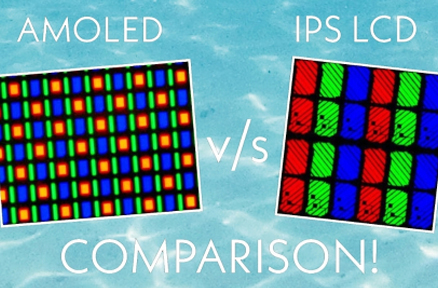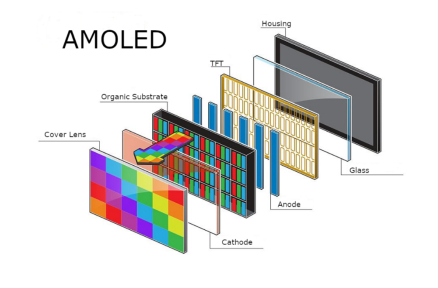What is AMOLED?
AMOLED is a kind of OLED screen. It has some cool extra features. OLED stands for two parts. First is Light Emitting Diode, or LED. Second is the “O,” which means organic. Together, they form OLED. This means organic stuff is placed between two conductors in each LED. That’s how light comes out.
An OLED screen makes light from single pixels. AMOLED screens have a Thin Film Translator, or TLT. This makes sending power to the right pixel faster and easier. The TLT also helps control many pixels at once. For example, some pixels can turn off completely. Others stay on in AMOLED screens. This creates a super dark black color.
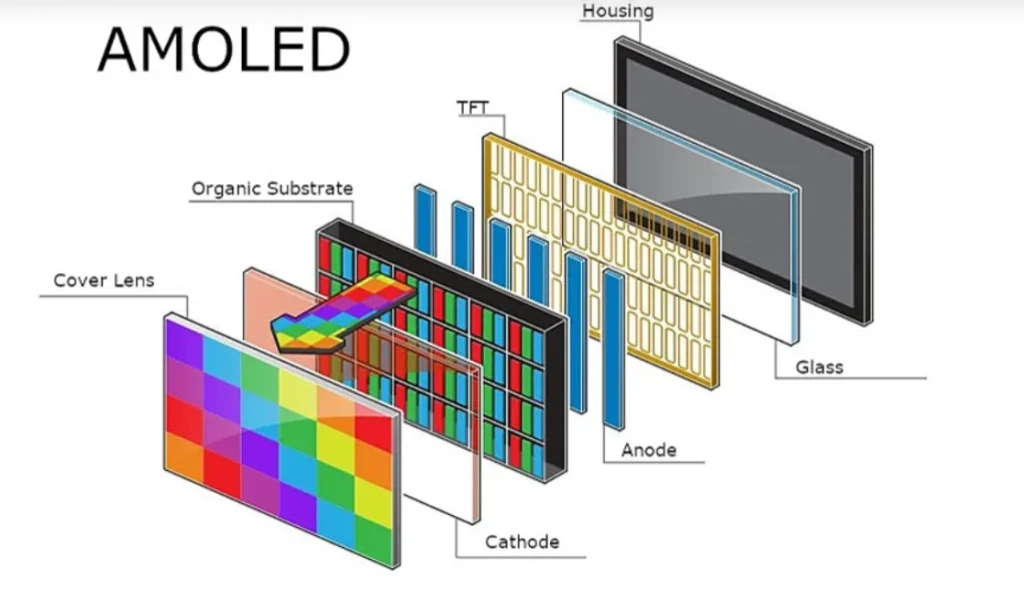
What is LCD?
LCD screens are super common in today’s phones. LCD means Liquid Crystal Display. It has a special backlight. This light is white or a bit blue. Often, a blue light passes through a yellowish filter. This makes white light. Then, the white light goes through more filters. After that, crystal parts pass through red, blue, and green filters.
LCD screens can be passive or active matrix. This depends on cost and needs. Since LCDs need more steps than AMOLED, they use more battery. The process is trickier. So, LCDs aren’t as battery-friendly as AMOLED screens.
What is AMOLED screen used for?
AMOLED display tech is mostly found in phones, music players, and cameras. AMOLED works well for low power, cheap, and big-size uses.
What are the differences between AMOLED and LCD displays?
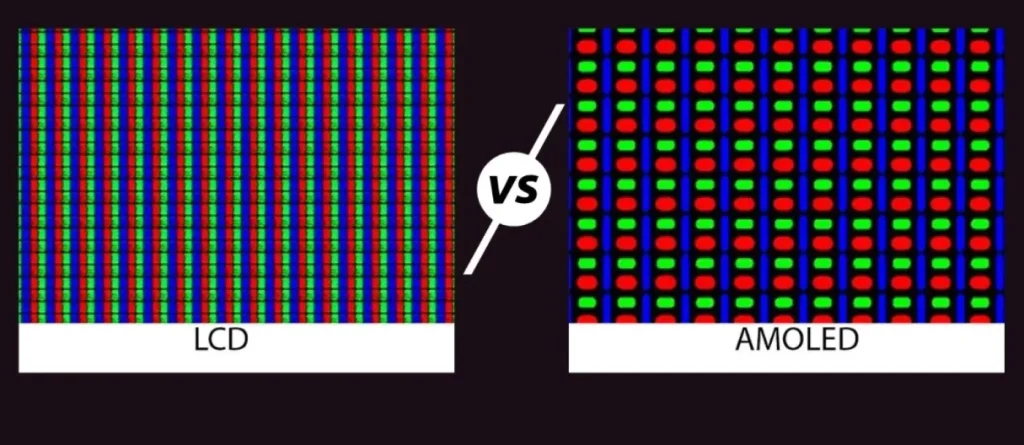
Cost
Cost is a big difference between these two screen types. AMOLED screens cost more than LCD screens. LCDs are cheaper to make. So, if you buy a low-cost phone, you’re less likely to get an AMOLED screen.
Colors
A screen’s quality depends on its colors and clarity. When comparing screens, just looking at tech isn’t enough. Sometimes, screens act differently even if they use the same tech.
For colors, especially bright ones like blue, red, or green, AMOLED does better all day. This happens because each pixel in AMOLED screens gives off its own light. In LCDs, light comes from a backlight. So, AMOLED screens show bold, lively colors. They have high saturation compared to LCD screens.
AMOLED screens make colors pop. They feel warmer. LCD screens have a neutral, whitish look. Pictures on AMOLED screens are easier on the eyes. On LCD screens, pictures look more real.
Brightness
Brightness is another thing to think about in AMOLED vs LCD screen comparison. AMOLED screens have lower brightness than LCD screens. This is because LCDs have a backlight. It gives off more light. So, if you’re outside a lot and use your phone in sunlight, LCD is better. But some top brands are improving AMOLED brightness.
Battery consumption
The screen eats up a lot of your phone’s battery. In AMOLED screens, pixels can turn off completely. This saves tons of battery. LCD screens rely on a backlight. Even if the screen is all black, the backlight stays on. That’s why AMOLED screens use less battery than LCD screens. Even though AMOLED costs more, it saves power.
Which is better? AMOLED or LCD?
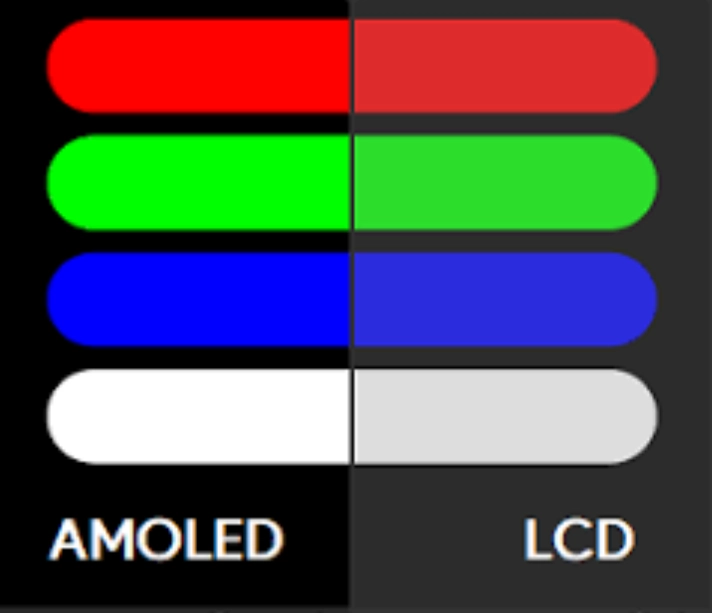
People always argue about AMOLED vs LCD. Which screen is best? AMOLED screens give awesome colors. They have deep black and eye-friendly contrast. LCD screens show softer colors. They have better viewing angles and brighter pictures.
When buying a new phone, we look at many things. These include software, camera, processor, battery, and screen type. The screen is a big deal for most people. AMOLED and LCD are two main screen types. In the LCD vs AMOLED debate, folks often get stuck. They don’t know which to pick. This article gives a clear comparison of AMOLED vs LCD screens. It helps figure out which is truly better.
In the fight of LCD vs AMOLED, both have good and bad points. If battery use and color pop matter to you, AMOLED wins over LCD. Today’s phone buyers focus on two things. They want low battery use and a great screen. AMOLED gives both. It has a vibrant, high-end display. It uses less power.
The only place LCD beats AMOLED is brightness. But new tech is coming. AMOLED is catching up to LCD in brightness. Also, the brightness gap in today’s AMOLED phones is barely noticeable.
Top AMOLED and LCD Display Manufacturer: Kadi Display
Kadi Display has a factory bigger than 5,000 square meters. They make LCM, TP, and BONDING on their own. They have a pro team for research. This team works on signal adapter boards, single-chip boards, and metal parts like aluminum.
Kadi Display uses Shenzhen’s special supply chain strengths. They give customers quick display solutions. At Kadi Display, they believe future success comes from talented people. So, they value each worker’s uniqueness. They cheer on their ideas. Every worker acts like an owner. They make each product with care. They serve every customer well.
The skilled team at Kadi Display is ready to help. Feel free to ask any tech questions. You can also request a custom display. Contact Kadi Display today!
FAQ
What are AMOLED screens used for?
AMOLED display tech is mostly used in phones, music players, and cameras. AMOLED works for low power, cheap, and big-size uses.
Are AMOLED displays better for battery life?
In AMOLED screens, pixels can turn off fully. This saves lots of battery. LCD screens need a backlight. Even if the screen is black, the backlight stays on. That’s why AMOLED uses less battery than LCD. Even though AMOLED costs more, it saves power.
Which type of screen offers better brightness?
AMOLED screens have less brightness than LCD screens. LCDs have a backlight. It gives off more light. So, if you use your phone outside in sunlight a lot, LCD is better. But some brands are working on AMOLED brightness.
Why are AMOLED screens more expensive?
Cost is a big difference between the two screen types. AMOLED screens cost more than LCD screens. LCDs are cheaper to make. So, in a low-budget phone, you’re less likely to find an AMOLED screen.
Latest Blog & News
- OLED – Organic Light Emitting Diode
- Passive Matrix vs Active Matrix - A Beginner's Guide
- Which Display for Raspberry Pi Interface Optimizes Touch Control: DSI MIPI or HDMI?
- Power of Industrial TFT LCD Touch Screen: Revolutionizing Interactivity
- What’s the Difference Between Anti-Reflection and Anti-Glare?








